H9N2 Avian Influenza Virus Downregulates FcRY Expression in Chicken Macrophage Cell Line HD11 by Activating the JNK MAPK Pathway
Abstract
1. Introduction
2. Results
2.1. Susceptibility of HD11 Cells to H9N2 Virus Infection and Identification of FcRY Expression
2.2. H9N2-Induced Infection Downregulated FcRY Expression in HD11 Cells
2.3. Role of MAPK Pathways in the Downregulation of FcRY in HD11 Cells by H9N2 Virus
2.4. Construction of Eukaryotic Expression Plasmids for H9N2 Viral Gene Segments and Their Effect on FcRY Expression
2.5. NS1 and M1 Downregulate FcRY Expression through the JNK MAPK Pathway
2.6. Construction of FcRY Promoter Luciferase Report Plasmids
3. Discussion
4. Materials and Methods
4.1. Cells and Virus
4.2. Plasmids, Antibodies, and Reagents
4.3. RNA Extraction and RT-qPCR Analysis
4.4. Western Blotting
4.5. Construction of Reporter Plasmids
4.6. Plasmid Transfection and Luciferase Assay
4.7. Indirect Immunofluorescence
4.8. Statistics and Data Analysis
5. Conclusions
Author Contributions
Funding
Institutional Review Board Statement
Informed Consent Statement
Data Availability Statement
Acknowledgments
Conflicts of Interest
References
- Kovacs-Nolan, J.; Mine, Y. Egg Yolk Antibodies for Passive Immunity. Annu. Rev. Food Sci. Technol. 2012, 3, 163–182. [Google Scholar] [CrossRef]
- Murai, A.; Hamano, T.; Kakiuchi, M.; Kobayashi, M.; Horio, F. Evaluation of a receptor gene responsible for maternal blood IgY transfer into egg yolks using bursectomized IgY-depleted chickens. Poult. Sci. 2020, 99, 1914–1920. [Google Scholar] [CrossRef] [PubMed]
- West, A.P.; Herr, A.B.; Bjorkman, P.J. The Chicken Yolk Sac IgY Receptor, a Functional Equivalent of the Mammalian MHC-Related Fc Receptor, Is a Phospholipase A2 Receptor Homolog. Immunity 2004, 20, 601–610. [Google Scholar] [CrossRef] [PubMed]
- Tesar, D.B.; Cheung, E.J.; Bjorkman, P.J. The Chicken Yolk Sac IgY Receptor, a Mammalian Mannose Receptor Family Member, Transcytoses IgY across Polarized Epithelial Cells. Mol. Biol. Cell 2008, 19, 1587–1593. [Google Scholar] [CrossRef] [PubMed]
- Choi, Y.; Kim, D.; Bang, O.; Kang, S.; Jin, E. Secretory phospholipase A2 promotes MMP-9-mediated cell death by degrading type I collagen via the ERK pathway at an early stage of chondrogenesis. Biol. Cell 2010, 102, 107–119. [Google Scholar] [CrossRef] [PubMed]
- Yang, W.; Liu, X.; Wang, X. The immune system of chicken and its response to H9N2 avian influenza virus. Vet. Q. 2023, 43, 1–14. [Google Scholar] [CrossRef] [PubMed]
- Qin, T.; Chen, Y.; Huangfu, D.; Miao, X.; Yin, Y.; Yin, Y.; Chen, S.; Peng, D.; Liu, X. PA-X protein of H9N2 subtype avian influenza virus suppresses the innate immunity of chicken bone marrow-derived dendritic cells. Poult. Sci. 2022, 102, 102304. [Google Scholar] [CrossRef]
- Smith, A.M.; Adler, F.R.; Ribeiro, R.M.; Gutenkunst, R.N.; McAuley, J.L.; McCullers, J.A.; Perelson, A.S. Kinetics of Coinfection with Influenza A Virus and Streptococcus pneumoniae. PLoS Pathog. 2013, 9, e1003238. [Google Scholar] [CrossRef]
- Guo, M.; Ni, J.; Yu, J.; Jin, J.; Ma, L.; Zhang, H.; Wang, D.; Zhang, X.; Dou, J.; Zhou, C. Antiviral Activity of Benzoic Acid Derivative NC-5 Against Influenza A Virus and Its Neuraminidase Inhibition. Int. J. Mol. Sci. 2019, 20, 6261. [Google Scholar] [CrossRef]
- Gao, S.; Song, L.; Li, J.; Zhang, Z.; Peng, H.; Jiang, W.; Wang, Q.; Kang, T.; Chen, S.; Huang, W. Influenza A virus-encoded NS1 virulence factor protein inhibits innate immune response by targeting IKK. Cell. Microbiol. 2012, 14, 1849–1866. [Google Scholar] [CrossRef]
- Wang, X.; Li, M.; Zheng, H.; Muster, T.; Palese, P.; Beg, A.A.; García-Sastre, A. Influenza A virus NS1 protein prevents activation of NF-κB and induction of alpha/beta interferon. J. Virol. 2000, 74, 11566–11573. [Google Scholar] [CrossRef]
- Ludwig, S.; Wang, X.; Ehrhardt, C.; Zheng, H.; Donelan, N.; Planz, O.; Pleschka, S.; García-Sastre, A.; Heins, G.; Wolff, T. The Influenza A Virus NS1 Protein Inhibits Activation of Jun N-Terminal Kinase and AP-1 Transcription Factors. J. Virol. 2002, 76, 11166–11171. [Google Scholar] [CrossRef]
- Yang, H.; Dong, Y.; Bian, Y.; Xu, N.; Wu, Y.; Yang, F.; Du, Y.; Qin, T.; Chen, S.; Peng, D. The influenza virus PB2 protein evades antiviral innate immunity by inhibiting JAK1/STAT signalling. Nat. Commun. 2022, 13, 6288. [Google Scholar] [CrossRef]
- Kim, C.-U.; Lim, D.; Kim, Y.S.; Ku, B.; Kim, D.-J. Influenza viral matrix 1 protein aggravates viral pathogenicity by inducing TLR4-mediated reactive oxygen species production and apoptotic cell death. Cell Death Dis. 2023, 14, 1–12. [Google Scholar] [CrossRef]
- Yang, J.; Li, Z.D.; Hou, C.Y.; Li, Z.Y.; Li, Q.; Miao, S.Y.; Zhang, Q.; Zhang, X.Y.; Zhu, X.F.; Jiang, J.W. EM-2 inhibited autophagy and promoted G2/M phase arrest and apoptosis by activating the JNK pathway in hepatocellular carcinoma cells. Acta Pharmacol. Sin. 2021, 42, 1139–1149. [Google Scholar] [CrossRef]
- Pleschka, S.; Wolff, T.; Ehrhardt, C.; Hobom, G.; Planz, O.; Rapp, U.R.; Ludwig, S. Influenza virus propagation is impaired by inhibition of the Raf/MEK/ERK signalling cascade. Nat. Cell Biol. 2001, 3, 301–305. [Google Scholar] [CrossRef]
- Dong, W.; Wei, X.; Zhang, F.; Hao, J.; Huang, F.; Zhang, C.; Liang, W. A dual character of flavonoids in influenza A virus replication and spread through modulating cell-autonomous immunity by MAPK signaling pathways. Sci. Rep. 2014, 4, 7237. [Google Scholar] [CrossRef] [PubMed]
- Ip, Y.T.; Davis, R.J. Signal transduction by the c-Jun N-terminal kinase (JNK)—From inflammation to development. Curr. Opin. Cell Biol. 1998, 10, 205–219. [Google Scholar] [CrossRef] [PubMed]
- Eferl, R.; Wagner, E.F. AP-1: A double-edged sword in tumorigenesis. Nat. Rev. Cancer 2003, 3, 859–868. [Google Scholar] [CrossRef] [PubMed]
- Qian, S.; Li, C.; Liu, X.; Jia, X.; Xiao, Y.; Li, Z. Activation of the JNK/MAPK Signaling Pathway by TGF-β1 Enhances Neonatal Fc Receptor Expression and IgG Transcytosis. Microorganisms 2021, 9, 879. [Google Scholar] [CrossRef] [PubMed]
- Taylor, P.; Martinez-Pomares, L.; Stacey, M.; Lin, H.-H.; Brown, G.; Gordon, S. Macrophage receptors and immune recognition. Annu. Rev. Immunol. 2005, 23, 901–944. [Google Scholar] [CrossRef] [PubMed]
- Twigg, H.L. Seminars in respiratory and critical care medicine. In Macrophages in Innate and Acquired Immunity; Thieme Medical Publishers, Inc.: New York, NY, USA, 2004; pp. 21–31. [Google Scholar]
- Klasing, K. Avian macrophages: Regulators of local and systemic immune responses. Poult. Sci. 1998, 77, 983–989. [Google Scholar] [CrossRef] [PubMed]
- Dong, C.; Davis, R.J.; Flavell, R.A. MAP Kinases in the Immune Response. Annu. Rev. Immunol. 2002, 20, 55–72. [Google Scholar] [CrossRef] [PubMed]
- Tripathi, P.; Aggarwal, A. NF-kB transcription factor: A key player in the generation of immune response. Curr. Sci. 2006, 90, 519–531. [Google Scholar]
- Qi, X.; Liu, C.; Li, R.; Zhang, H.; Xu, X.; Wang, J. Modulation of the innate immune-related genes expression in H9N2 avian influenza virus-infected chicken macrophage-like cells (HD11) in response to Escherichia coli LPS stimulation. Res. Vet. Sci. 2017, 111, 36–42. [Google Scholar] [CrossRef] [PubMed]
- East, L.; Isacke, C.M. The mannose receptor family. Biochim. Biophys. Acta (BBA) Gen. Subj. 2002, 1572, 364–386. [Google Scholar] [CrossRef]
- Sheikh, H.; Yarwood, H.; Ashworth, A.; Isacke, C.M. Endo180, an endocytic recycling glycoprotein related to the macrophage mannose receptor is expressed on fibroblasts, endothelial cells and macrophages and functions as a lectin receptor. J. Cell Sci. 2000, 113, 1021–1032. [Google Scholar] [CrossRef] [PubMed]
- Reading, P.C.; Miller, J.L.; Anders, E.M. Involvement of the Mannose Receptor in Infection of Macrophages by Influenza Virus. J. Virol. 2000, 74, 5190–5197. [Google Scholar] [CrossRef]
- Marvin, S.A.; Russier, M.; Huerta, C.T.; Russell, C.J.; Schultz-Cherry, S. Influenza Virus Overcomes Cellular Blocks To Productively Replicate, Impacting Macrophage Function. J. Virol. 2017, 91, e01417-16. [Google Scholar] [CrossRef]
- Wang, J.; Nikrad, M.P.; Travanty, E.A.; Zhou, B.; Phang, T.; Gao, B.; Alford, T.; Ito, Y.; Nahreini, P.; Hartshorn, K.; et al. Innate Immune Response of Human Alveolar Macrophages during Influenza A Infection. PLoS ONE 2012, 7, e29879. [Google Scholar] [CrossRef]
- Campbell, G.M.; Nicol, M.Q.; Dransfield, I.; Shaw, D.J.; Nash, A.A.; Dutia, B.M. Susceptibility of bone marrow-derived macrophages to influenza virus infection is dependent on macrophage phenotype. J. Gen. Virol. 2015, 96, 2951–2960. [Google Scholar] [CrossRef] [PubMed]
- The SJCEIRS H9 Working Group; Schultz-Cherry, S.; Thomas, P. Assessing the fitness of distinct clades of influenza A (H9N2) viruses. Emerg. Microbes Infect. 2013, 2, 1–11. [Google Scholar] [CrossRef]
- Xing, Z.; Cardona, C.J.; Anunciacion, J.; Adams, S.; Dao, N. Roles of the ERK MAPK in the regulation of proinflammatory and apoptotic responses in chicken macrophages infected with H9N2 avian influenza virus. J. Gen. Virol. 2009, 91, 343–351. [Google Scholar] [CrossRef] [PubMed]
- Xie, J.; Zhang, S.; Hu, Y.; Li, D.; Cui, J.; Xue, J.; Zhang, G.; Khachigian, L.M.; Wong, J.; Sun, L.; et al. Regulatory roles of c-jun in H5N1 influenza virus replication and host inflammation. Biochim. Biophys. Acta (BBA) Mol. Basis Dis. 2014, 1842, 2479–2488. [Google Scholar] [CrossRef]
- Schreiber, M.; Kolbus, A.; Piu, F.; Szabowski, A.; Möhle-Steinlein, U.; Tian, J.; Karin, M.; Angel, P.; Wagner, E.F. Control of cell cycle progression by c-Jun is p53 dependent. Minerva Anestesiol. 1999, 13, 607–619. [Google Scholar] [CrossRef]
- Verrecchia, F.; Tacheau, C.; Schorpp-Kistner, M.; Angel, P.; Mauviel, A. Induction of the AP-1 members c-Jun and JunB by TGF-β/Smad suppresses early Smad-driven gene activation. Oncogene 2001, 20, 2205–2211. [Google Scholar] [CrossRef] [PubMed]
- Takakura, M.; Kyo, S.; Inoue, M.; Wright, W.E.; Shay, J.W. Function of AP-1 in Transcription of the Telomerase Reverse Transcriptase Gene (TERT) in Human and Mouse Cells. Mol. Cell. Biol. 2005, 25, 8037–8043. [Google Scholar] [CrossRef]
- Bushel, P.; Kim, J.H.; Chang, W.; Catino, J.J.; E Ruley, H.; Kumar, C.C. Two serum response elements mediate transcriptional repression of human smooth muscle alpha-actin promoter in ras-transformed cells. Oncogene 1995, 10, 1361–1370. [Google Scholar]
- Hale, B.G.; Randall, R.E.; Ortín, J.; Jackson, D. The multifunctional NS1 protein of influenza A viruses. J. Gen. Virol. 2008, 89, 2359–2376. [Google Scholar] [CrossRef]
- Nacken, W.; Anhlan, D.; Hrincius, E.R.; Mostafa, A.; Wolff, T.; Sadewasser, A.; Pleschka, S.; Ehrhardt, C.; Ludwig, S. Activation of c-jun N-Terminal Kinase upon Influenza A Virus (IAV) Infection Is Independent of Pathogen-Related Receptors but Dependent on Amino Acid Sequence Variations of IAV NS1. J. Virol. 2014, 88, 8843–8852. [Google Scholar] [CrossRef][Green Version]
- Glaser, N.D.; Lukyanenko, Y.O.; Wang, Y.; Wilson, G.M.; Rogers, T.B. JNK activation decreases PP2A regulatory subunit B56α expression and mRNA stability and increases AUF1 expression in cardiomyocytes. Am. J. Physiol. Circ. Physiol. 2006, 291, H1183–H1192. [Google Scholar] [CrossRef] [PubMed]
- Vargas, N.B.; Brewer, B.Y.; Rogers, T.B.; Wilson, G.M. Protein kinase C activation stabilizes LDL receptor mRNA via the JNK pathway in HepG2 cells. J. Lipid Res. 2009, 50, 386–397. [Google Scholar] [CrossRef]
- Saito, S.; Takayama, I.; Nakauchi, M.; Nagata, S.; Oba, K.; Odagiri, T.; Kageyama, T. Development and evaluation of a new real-time RT-PCR assay for detecting the latest H9N2 influenza viruses capable of causing human infection. Microbiol. Immunol. 2019, 63, 21–31. [Google Scholar] [CrossRef]
- Chen, Y.; Jin, H.; Chen, P.; Li, Z.; Meng, X.; Liu, M.; Li, S.; Shi, D.; Xiao, Y.; Wang, X. Haemophilus parasuis infection activates the NF-κB pathway in PK-15 cells through IκB degradation. Vet. Microbiol. 2012, 160, 259–263. [Google Scholar] [CrossRef] [PubMed]
- Hua, K.; Li, Y.; Zhou, H.; Hu, X.; Chen, Y.; He, R.; Luo, R.; Zhou, R.; Bi, D.; Jin, H. Haemophilus parasuis Infection Disrupts Adherens Junctions and Initializes EMT Dependent on Canonical Wnt/β-Catenin Signaling Pathway. Front. Cell. Infect. Microbiol. 2018, 8, 324. [Google Scholar] [CrossRef] [PubMed]
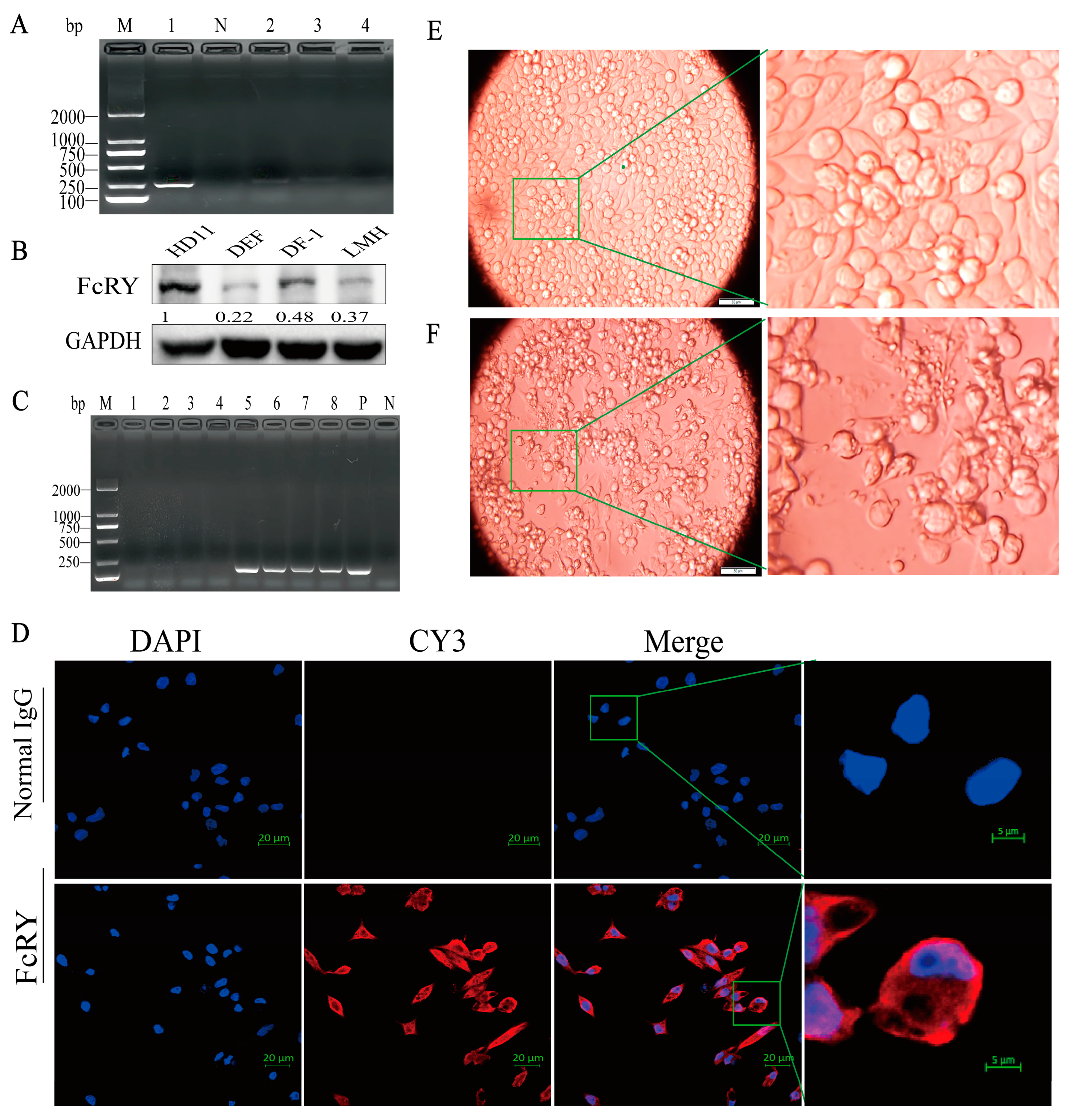
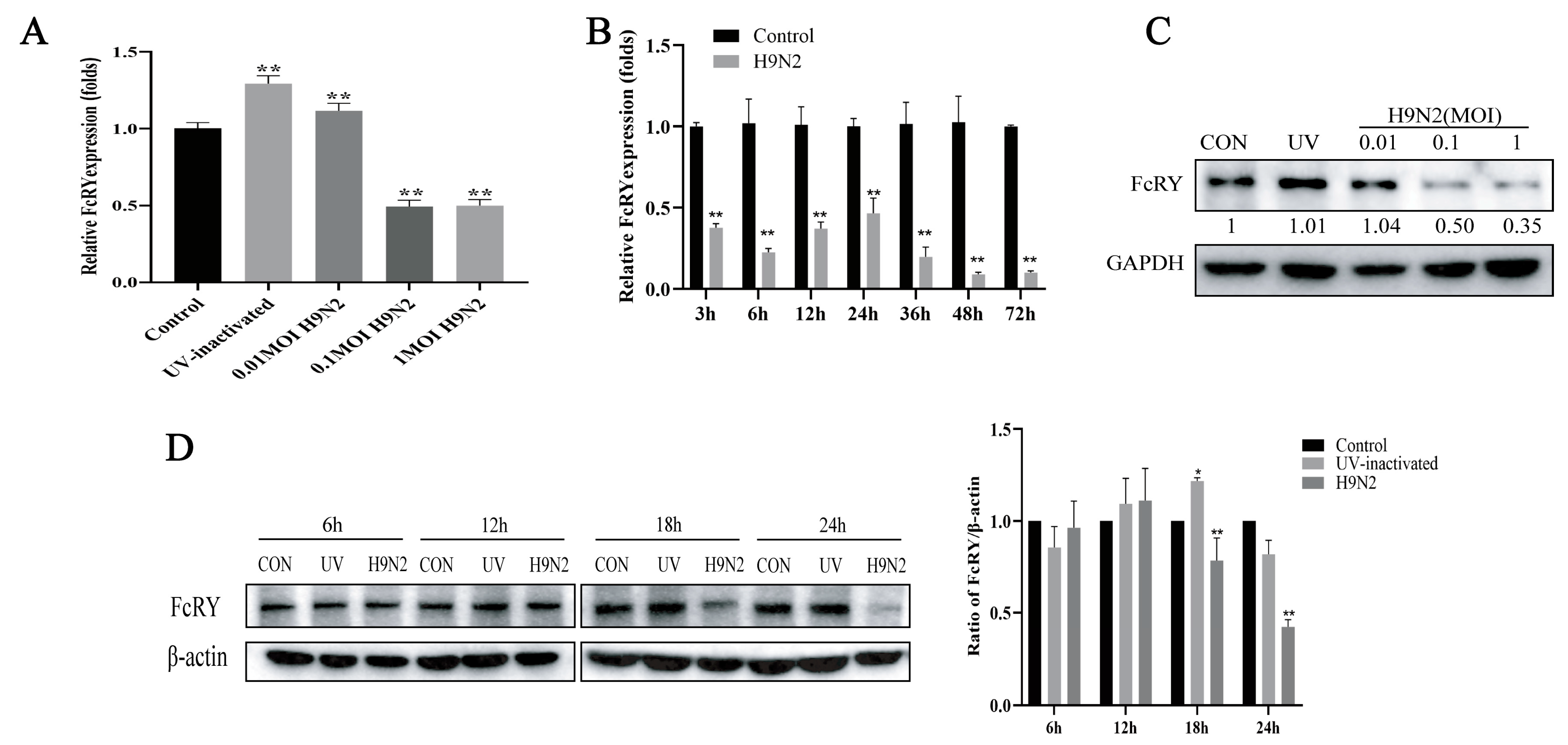
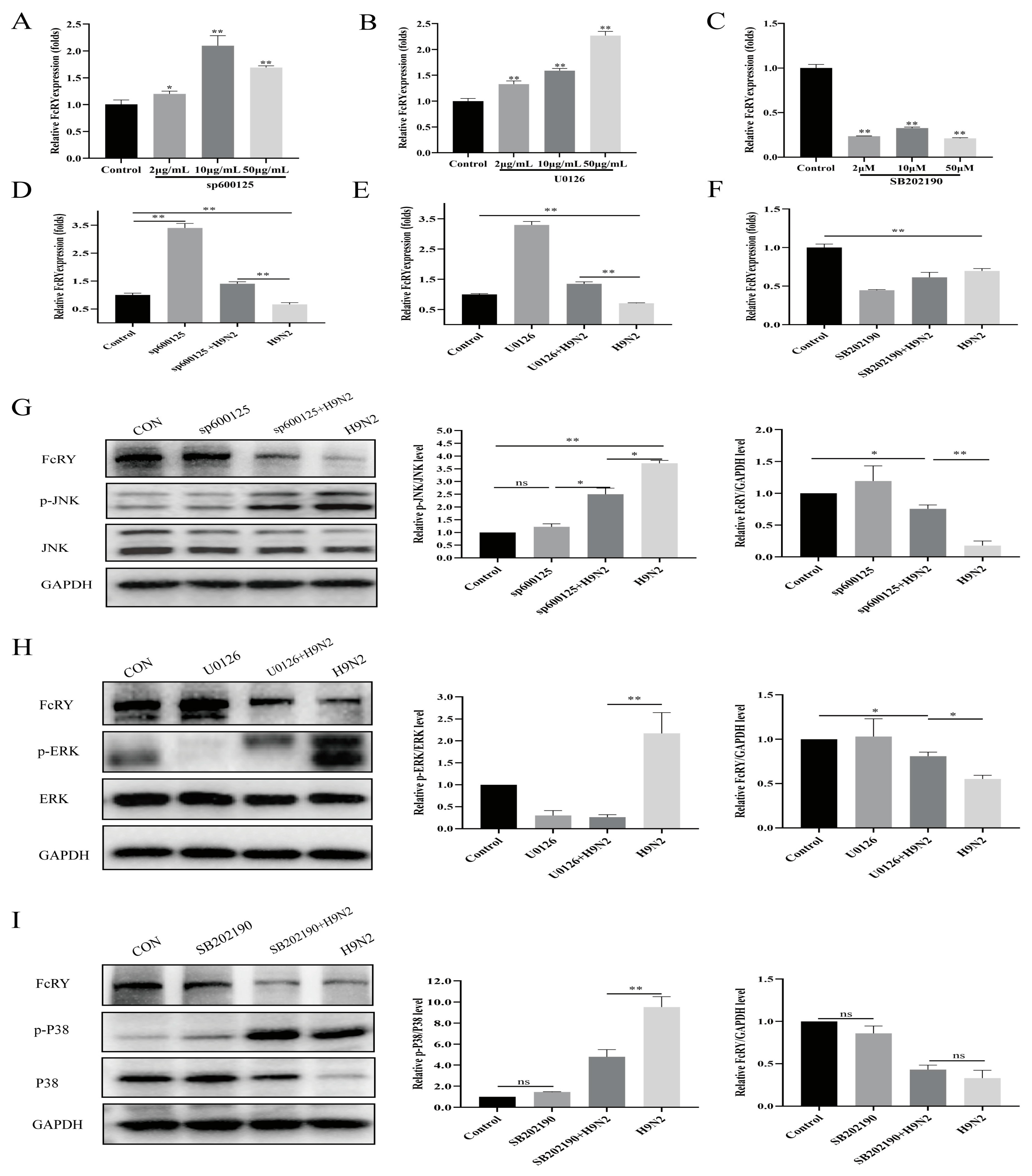
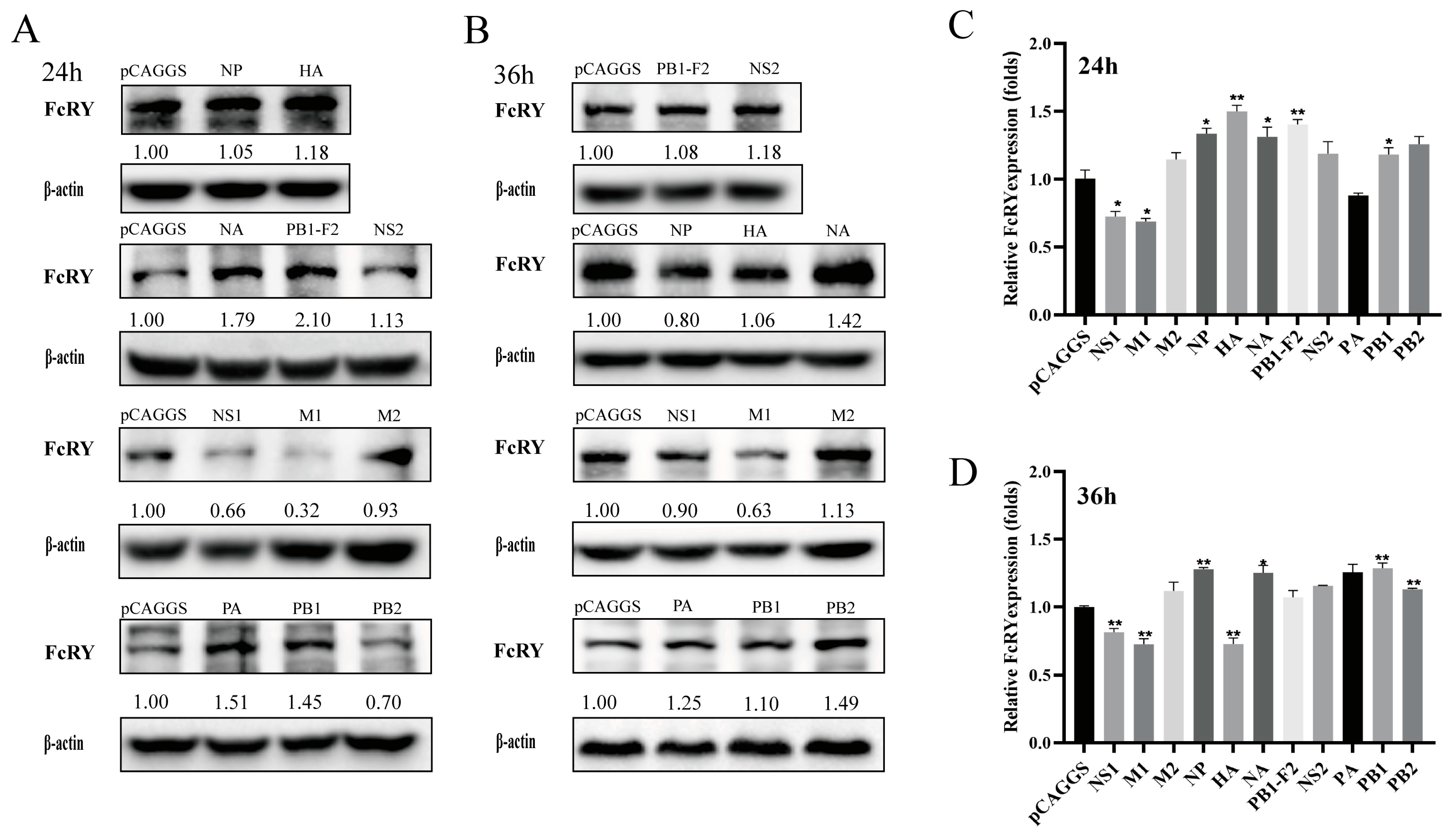

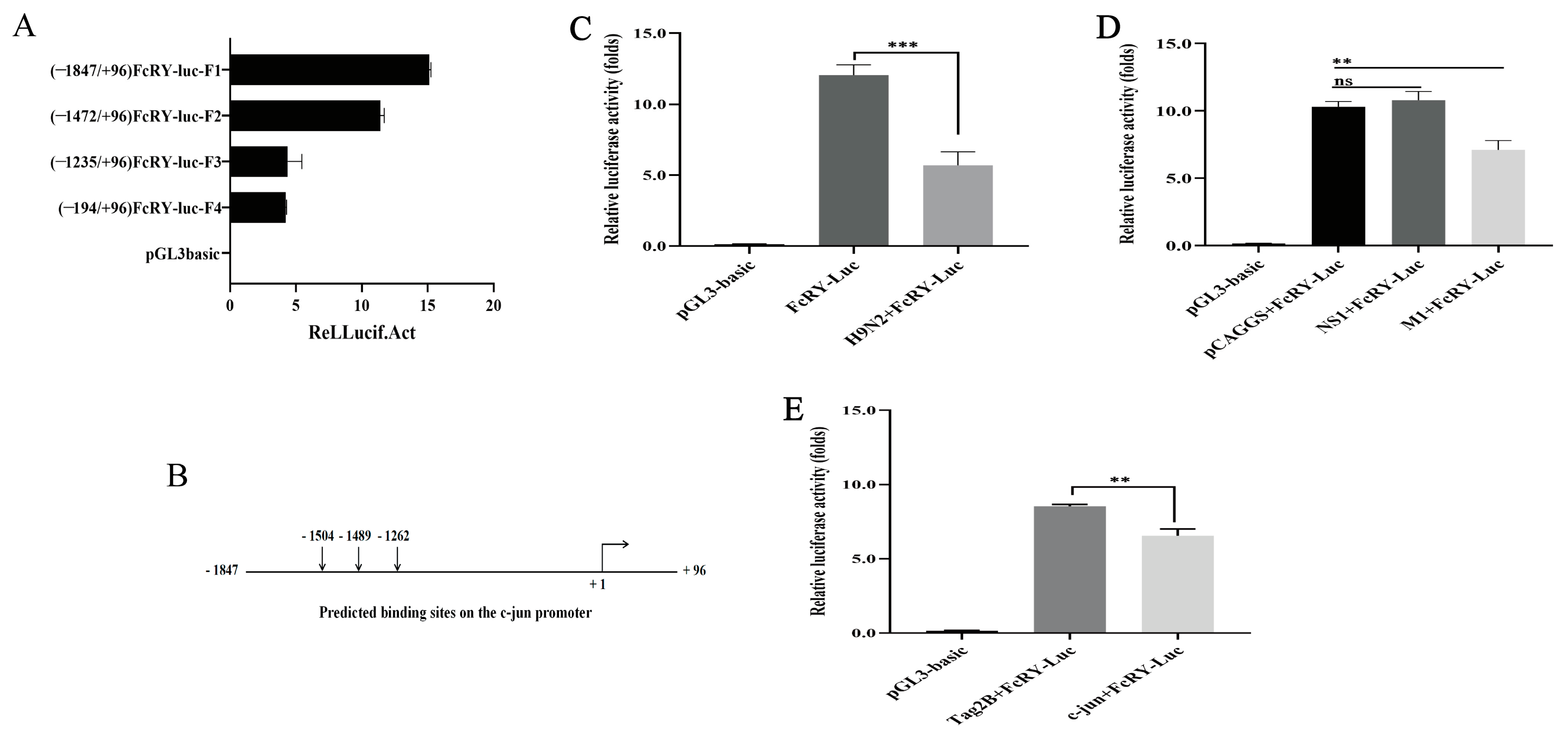
| Target | Forward Primer (5′-3′) | Reverse Primer (5′-3′) |
|---|---|---|
| β-actin | TTGTTGACAATGGCTCCGGT | TCTGGGCTTCATCACCAACG |
| H9N2 | AATGTYCCTGTGACACATGCCAA | AGRTCACAAGAAGGRTTGCCATA |
| FcRY | GCTACACAAACTGGAACAAGCA | CTTCTGACTCCCACCCAAAGT |
| FcRY-luc-F1 | GGGGTACCGTGTTCAGCAGTTGGACGT | GAAGATCTCGCCGCGGCTTGGCACGAC |
| FcRY-luc-F2 | GGGGTACCAGGGTCCTCGAAAAACAGATCATC | GAAGATCTCGCCGCGGCTTGGCACGAC |
| FcRY-luc-F3 | GGGGTACCAGAGCTGCCCAGAATAAGCAAGTTGC | GAAGATCTCGCCGCGGCTTGGCACGAC |
| FcRY-luc-F4 | GGGGTACCAGCCGTTCCTCCCCCCGAG | GAAGATCTCGCCGCGGCTTGGCACGAC |
| pCMV-c-jun | CAGGAATTCGATATCAAGCTTATGAGTGCAAAGATGGAGC | GGTACCGGGCCCCCCCTCGAGTCAAAACGTTTGCAACTGT |
| pCAGGS-NP | CGGAATTCATGGCGCTTCAAGGCACC | CCTCGAGTTAATTGTCATACTCCTCTGCATTGTC |
| pCAGGS-HA | CGAGCTCATGGAAGTAGTATCACTA | GCTCGAGTTATATACAAATGTTGCATCTGC |
| pCAGGS-NA | GAGCTCATGAATCCAAATCAGAAGATAATAGC | CCTCGAGTTATATAGGCATGA AGTTGATATTCGC |
| pCAGGS-PB1-F2 | CCGGAATTCATGGATCCA AACACTGTGTC | CCTCGAGCTATTTTGGAGAGAGTGGAGG |
| pCAGGS-NS2 | CGAATTCATGGATCCAAACACTGTGTCAAGCTT | GCTCGAGTTAAATAAGCTGAAACGAGAAAGTTC |
| pCAGGS-M1 | CGAATTCATGAGCCTTCTAACCGAGG | GCTCGAGTCACTTGAATCGCTGCATC |
| pCAGGS-M2 | GGAATTCATGAGCCTTCTAACCGAGGTCGAAAC | GCTCGAGTTACTCCAGCTCTATGTTGAC |
| pCAGGS-PA | TTCCAGATTACGCTGAATTCATGGAAGATTTTGT | TTAAGATCTGCTAGCTCACGCTATTTCAGTGCAT |
| pCAGGS-PB1 | GGCATGCCCGGGTACCATGGATGTCAATCCGA | TGTTCCATGGCTGTATGGGGGATCTCCAGTATAA |
| pCAGGS-PB2 | AGAGCTAATGTCGCAATCCCGCACCCGCGAGAT | AACACTACTTGTCCCGCCTGATACTGGTAGGAA |
| pCAGGS-NS1 | GGAATTCATGGATCCAAACACTGTGTCAAGC | CCTCGAGCTATTTTGGAGAGAGTGGAGGTCT |
| pCAGGS-M1 | CGAATTCATGAGCCTTCTAACCGAGG | GCTCGAGTCACTTGAATCGCTGCATC |
Disclaimer/Publisher’s Note: The statements, opinions and data contained in all publications are solely those of the individual author(s) and contributor(s) and not of MDPI and/or the editor(s). MDPI and/or the editor(s) disclaim responsibility for any injury to people or property resulting from any ideas, methods, instructions or products referred to in the content. |
© 2024 by the authors. Licensee MDPI, Basel, Switzerland. This article is an open access article distributed under the terms and conditions of the Creative Commons Attribution (CC BY) license (https://creativecommons.org/licenses/by/4.0/).
Share and Cite
Sun, Z.; Zhang, W.; Li, J.; Yang, K.; Zhang, Y.; Li, Z. H9N2 Avian Influenza Virus Downregulates FcRY Expression in Chicken Macrophage Cell Line HD11 by Activating the JNK MAPK Pathway. Int. J. Mol. Sci. 2024, 25, 2650. https://doi.org/10.3390/ijms25052650
Sun Z, Zhang W, Li J, Yang K, Zhang Y, Li Z. H9N2 Avian Influenza Virus Downregulates FcRY Expression in Chicken Macrophage Cell Line HD11 by Activating the JNK MAPK Pathway. International Journal of Molecular Sciences. 2024; 25(5):2650. https://doi.org/10.3390/ijms25052650
Chicago/Turabian StyleSun, Zhijian, Wenjie Zhang, Jian Li, Kang Yang, Yanhao Zhang, and Zili Li. 2024. "H9N2 Avian Influenza Virus Downregulates FcRY Expression in Chicken Macrophage Cell Line HD11 by Activating the JNK MAPK Pathway" International Journal of Molecular Sciences 25, no. 5: 2650. https://doi.org/10.3390/ijms25052650
APA StyleSun, Z., Zhang, W., Li, J., Yang, K., Zhang, Y., & Li, Z. (2024). H9N2 Avian Influenza Virus Downregulates FcRY Expression in Chicken Macrophage Cell Line HD11 by Activating the JNK MAPK Pathway. International Journal of Molecular Sciences, 25(5), 2650. https://doi.org/10.3390/ijms25052650






